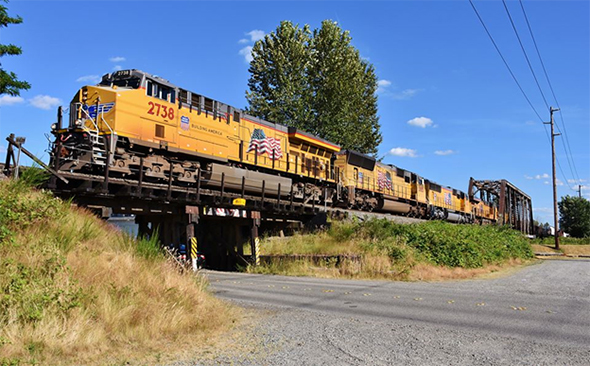
The FRA released an ICR dealing with grant accountability in the railroad industry. A Union Pacific manifest freight train thunders over the Green River Bride in Kent, Washington on June 26th, 2018. Photo © 6/2018 by Nikki Burgess; all rights reserved.
Need we say it? Be safe with fireworks! This week’s holiday is no reason to endure a tragedy. The safest course is to leave that kind of celebrating to the industry professionals, and just sit back and watch them do their thing. The week’s news was surprisingly busy in what is often a sparse period; here’s the latest:
EPA
The agency released a notice dealing with its effort to create and implement unique identifiers for substances subject to the TSCA that are to be held as confidential business. The mandate for the program will allow businesses to register chemicals without fearing an accidental revelation of the data to competitors, if the substance qualifies for the program. See the details here
OSHA
- In a big announcement, the agency has published its intention to release a proposed rule in February of 2019 that will harmonize US Hazard Communication Standard with the most recent (7th) Revision of the GHS. OSHA’s 29 CFR 1910.12200 HCS is currently based on the 3rd Revision. An upgrade to the 7th Revision will bring the US into line with EU and pending Canadian practice. Whether the current friction between the US and its EU and Canadian trade partners will affect the rule is unknown at present. See the announcement here
- The agency published a minor correction to the 29 CFR, revising 1910.1000. That section deals with air contaminants. See the correction right here
- Another correction revised Part 1910.999 dealing with storage of containers of flammable liquid. See that correction here
- The agency also renewed its major information collection associated with the Bloodborne Pathogens Standard. See the renewal here
FMCSA
FMCSA proposes to amend the entry-level driver training (ELDT) regulations published on December 8, 2016, titled ‘‘Minimum Training Requirements for Entry-Level Commercial Motor Vehicle Operators’’ by adopting a new Class A theory instruction upgrade curriculum to reduce the training time and costs incurred by Class B commercial driver’s license (CDL) holders upgrading to a Class A CDL. This NPRM does not propose any changes to behind-the-wheel (BTW) training requirements set forth in the ELDT final rule. Here’s the proposal
FRA
The agency released an annual ICR dealing with its grant administration process. This process is available to eligible industry stakeholders for help with everything from employee safety to PTC implementation, depending on the grant program. The ICR mandates that grant recipients provide feedback and accountability to the FRA on their use of the program funding. See the ICR here
Labelmaster is a full service provider of products, shipping and training software, and professional consulting services to assist the DG and HS&E professional to comply with national and international regulations. See our full line of solutions at www.labelmaster.com



